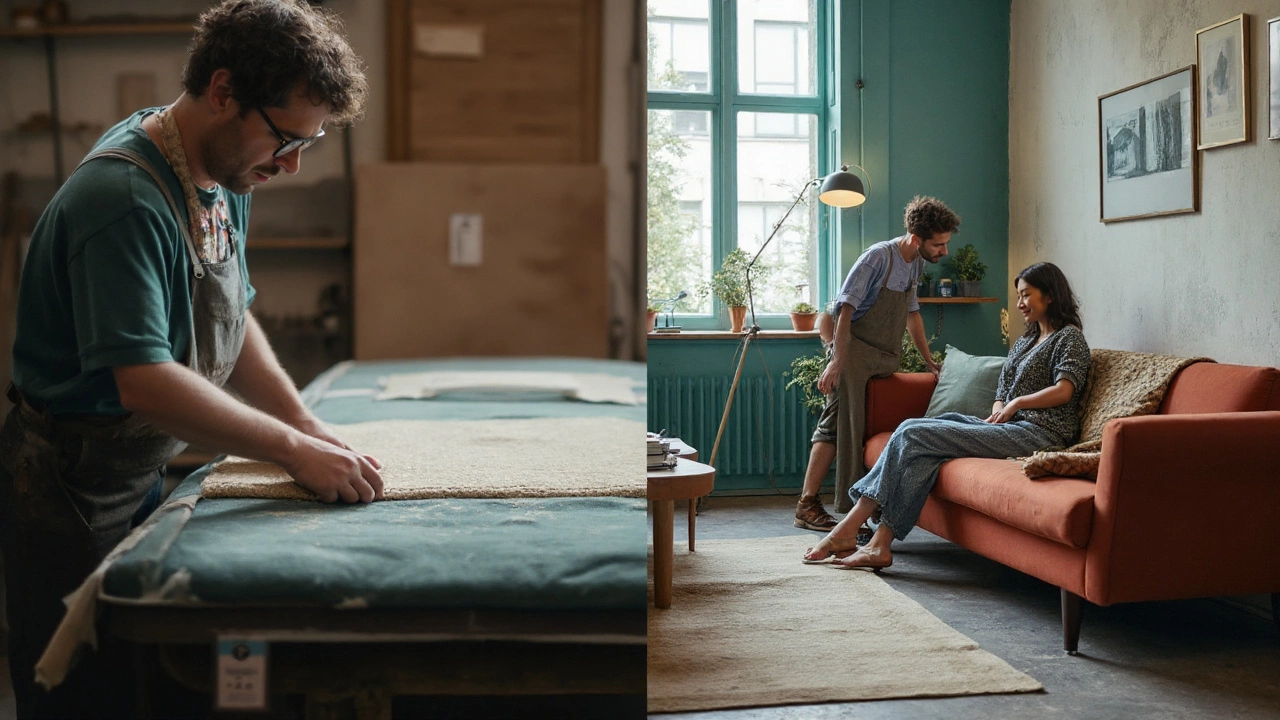How Often Should You Replace Your Couch? Lifespan, Signs, and Smart Fix-or-Buy Rules

You don’t need a crystal ball to know when a couch is done. You need a few quick tests, a couple of price guardrails, and a straight answer on lifespan. The real kicker? How long a sofa lasts isn’t just about years; it’s about the frame, suspension, foam density, and how many people (and paws) pile onto it. I live in Auckland, and between humidity and two kids who treat our lounge like a trampoline park, I’ve replaced more couches than I’m proud of. The goal here is simple: help you decide if you should keep it, fix it, or swap it-and make sure the next one lasts longer.
TL;DR
- Typical replacement window: budget/flat-pack couches 3-5 years; mainstream mid-range 7-10 years; high-quality hardwood frames 12-20 years.
- Replace when: the frame creaks or wobbles, springs are broken, seat sag is 2 cm+ that doesn’t rebound, or odors/stains won’t budge.
- Repair when: the frame is solid but cushions, fabric, or legs are tired. Reupholstery can outlast buying cheap again.
- Money rule: if repair costs exceed 50% of a comparable new sofa and yours is past half its expected life, buy new.
- Make it last: choose kiln-dried hardwood + sinuous or 8-way springs, foam density 2.0 lb/ft³+ (34 kg/m³+), and rotate/clean cushions monthly.
How long does a couch last? Real timelines that actually match your life
The honest answer: it depends on build quality and how you use it. A couch in a student flat will age in dog years. A well-built sofa in a quiet home can sail past a decade. Industry testing backs this up-durability is driven by frame material and joinery, suspension type, foam density, and fabric abrasion resistance. Groups like the American Home Furnishings Alliance outline construction standards, and fabric wear is rated by ACT performance guidelines (Wyzenbeek/Martindale). Here’s a clear view you can use.
| Component | What to look for | Typical lifespan | Quick at-home check |
|---|---|---|---|
| Frame | Kiln-dried hardwood, corner blocks, glued/screwed joints | 12-20 years | Lift one front leg 5 cm; other front leg should lift too. If not, flex/wobble suggests weak frame. |
| Frame | Softwood/plywood mix, fewer corner blocks | 7-12 years | Rock test: sit and shift weight; listen for creaks and feel for twist. |
| Frame | Particle board/MDF, stapled joints | 3-5 years | Press on arm/rail; if it flexes or you hear cracking, it’s short-lived. |
| Suspension | 8-way hand-tied springs | 15-20 years | Remove cushion and press; consistent, quiet resistance = good. |
| Suspension | Sinuous (S) springs | 8-12 years | Press along seat front-to-back; localized dips = broken clip or spring. |
| Suspension | Webbing only | 3-7 years | Seat feels like a hammock? Webbing has stretched or failed. |
| Cushions | HR foam 2.0-2.5 lb/ft³ (34-40 kg/m³) | 7-12 years | Pinch test: foam rebounds quickly and holds shape. |
| Cushions | Standard foam ~1.5-1.8 lb/ft³ (24-29 kg/m³) | 3-6 years | Edges look rounded/flat, permanent butt-print = low density. |
| Cushions | Down/feather blend | 5-10 years | Needs regular fluffing; great feel but more upkeep. |
| Fabric | Woven polyester/olefin; Wyzenbeek 30,000+ double rubs | 7-12 years | No pilling, no shiny wear at seats/arms after a few years = holding up. |
| Fabric | Cotton/linen, low abrasion rating | 3-7 years | Check for fraying on seams and arm fronts. |
| Leather | Top-grain, aniline or semi-aniline | 10-20 years | Develops patina, not paint-like peeling. |
Usage is the other half of the equation. A family of four with a dog, daily TV time, and weekend guests will age a sofa 30-50% faster than a single person who works long hours. In my place, the couch we bought in 2014 tapped out in year nine. Solid frame, decent foam, but the suspension started groaning, and the seat sag never bounced back-classic mid-range lifespan.
Heuristics you can trust:
- Budget/flat-pack: plan on 3-5 years.
- Mid-range retail (good plywood/springs): 7-10 years.
- Quality hardwood + springs: 12-20 years.
- Heavy daily use or pets: subtract 1-3 years.
- Light use (formal lounge): add 2-5 years.
Independent testing backs this. Consumer Reports has long pegged average sofa life at about 7-15 years depending on construction. Fabric durability ratings from ACT and Martindale/Wyzenbeek tests show that higher abrasion ratings correlate with longer real-world wear on arms and seats.
Signs it’s time to replace (and when a quick fix actually works)
You don’t need to take the couch apart. These simple checks will tell you if it’s time.
- Sag depth: remove the cushion, lay a straight edge across the seat, and measure to the lowest point. More than 2 cm of permanent dip (that doesn’t recover after a day) = replacement or major repair.
- Noise audit: sit, shift, and stand. Creaks or metallic pings usually mean loose joints or a failing spring clip. If tightening screws doesn’t stop it, the frame/suspension is going.
- Wobble test: push the arm and back diagonally. Any racking movement points to a weak frame. Staples coming loose is a red flag.
- Fabric failure: threadbare arms, seams splitting, or holes in high-wear zones mean the fabric is past its abrasion rating. Slipcovers can buy time, but exposed foam or broken seams near stress points often call for reupholstery or replacement.
- Foam fatigue: cushions that pancake within minutes and don’t recover likely have low-density foam that’s oxidized. If you can squeeze and feel the plywood rail right through the cushion, it’s not supporting you.
- Odors and allergens: smoke, pet accidents, or mildew (Auckland humidity fans, you know) that persist after deep cleaning can make the couch a health problem. Mildew smell that returns = time to move on.
- Comfort changes: if you get up sore or feel pressure points on the rail, the suspension is tired. Comfort is a valid reason to retire a sofa even if it looks okay.
When a fix is enough:
- Loose legs or brackets: often a 10-minute repair with new bolts/plates.
- Flattened cushions but solid frame: new foam cores (higher density) can make a sofa feel new for a few hundred dollars.
- Small tears on removable covers: patching or replacing a single cover is inexpensive compared to a whole reupholstery.
- Slight sag with webbing: in some designs, you can re-web the platform. Costs vary but it’s doable.
Quick rule of thumb: structural problems (frame cracks, broken springs, twisted rails) = replace; surface problems (cushions, covers, feet) = repair.

Repair, reupholster, or replace? Costs, NZ price ranges, and decision rules
Let’s talk money, because that’s how most couch decisions get made.
New sofa prices in New Zealand (2025 snapshot from mainstream retailers and local makers):
- Budget flat-pack/online imports: NZ$500-$1,200
- Mid-range retail (better frames, sinuous springs): NZ$1,500-$4,000
- High-quality/custom hardwood + top-grain leather or premium fabric: NZ$5,000-$10,000+
Typical repair/reupholstery costs in NZ (varies by size/fabric):
- New high-density foam cores for seat cushions: NZ$200-$600 total
- Replace cushion inners (down/feather blend): NZ$300-$800
- Re-webbing or replacing sinuous springs: NZ$300-$900
- Full reupholstery (3-seater), including new foam and labor: NZ$1,200-$3,500 for common fabrics; premium leather much higher
- Slipcover (custom, washable): NZ$500-$1,500
Decision rules that keep you from overspending:
- The 50% Rule: if repair costs exceed 50% of a comparable new sofa and yours is beyond half of its expected lifespan, buy new.
- The Sentimental/Heirloom Exception (20% Rule): if the frame is high quality (kiln-dried hardwood, solid joinery), reupholstering at up to 80% of a new couch price can be smart. You’ll get another 10+ years and keep a well-built frame out of landfill.
- The Hidden Cost Check: factor delivery, disposal fees, and your time. Auckland inorganic collections are seasonal, and private pickup can add NZ$60-$150. A repair that avoids all that might be a better total deal.
- The Comfort Test: if you don’t enjoy sitting on it, no spreadsheet will save it. Comfort is the product.
What about sustainability? A sturdy frame is worth saving. Reupholstery keeps cubic meters of waste out of landfill and often outperforms buying cheap again. If the couch still sits well but looks tired, this is the move. But if the bones are gone-wobbly arms, cracked rails-don’t throw good money after bad.
Disposal and donation:
- If it’s clean, safe, and odor-free: check with local charities or reuse shops. Many will accept only if fabric and frames are sound.
- If it’s broken or stained: book council disposal or a private remover. Remove legs to save space, and strip metal fasteners for recycling where possible.
- Leather and fabric offcuts: some repairers will take offcuts; ask when you schedule removal.
A real-world example from my house: our nine-year-old mid-range sofa had solid arms and a decent frame, but springs were complaining and the sag was obvious. Quotes came back: NZ$1,800 to reupholster with new foam and re-tie springs, NZ$2,400 for a new mid-range model we liked. We chose new. If the frame had been kiln-dried hardwood, I would’ve reupholstered and pocketed the comfort upgrade.
Buy smarter and make your next couch last (checklists, pro tips, and a maintenance plan)
Here’s the part that saves you money every year you own the sofa. Make these choices now, and you won’t be shopping again in three years.
Buying checklist (what really matters):
- Frame: kiln-dried hardwood (oak, ash, beech). Ask about corner blocks and glued/screwed joints. Avoid frames that flex when you press on the arms.
- Suspension: sinuous springs minimum; 8-way hand-tied for heirloom builds. Skip webbing-only seats for daily-use couches.
- Cushions: high-resilience foam 2.0 lb/ft³ (34 kg/m³) or higher. If you like a soft sit, choose foam core with a down/feather or fiber wrap.
- Fabric: look for abrasion ratings-Wyzenbeek 30,000+ double rubs (or Martindale 40,000+) for high-traffic homes. Woven blends (poly/olefin) resist pilling and stains better than loosely woven naturals.
- Leather: top-grain aniline or semi-aniline ages well. Bonded or “split leather” peels and cracks early.
- Seat depth and height: if your feet dangle or you slouch, your back will hate it-and you’ll replace it early. Sit-test with how you actually relax at home.
- Replaceable parts: zip-off cushion covers and removable legs make cleaning and repairs simpler.
- Warranty: frames/springs should carry multi-year coverage. Read the fine print on cushions and fabric.
Pro tips to extend life:
- Rotate and flip (if flippable) cushions monthly. Swap left and right seats; humans have favorite spots that wear faster.
- Vacuum seams weekly. Grit is sandpaper for fabric and foam.
- Use arm covers on the high-contact zones or a neat throw in the TV corner.
- Manage humidity. In Auckland, a dehumidifier in winter keeps mildew (and odor) away and protects foam.
- Keep 10-15 cm from heaters and out of direct sun. UV fades fabric and dries leather.
- Spot clean the day stains happen. Oil and dye transfers set fast.
- Add felt glides to feet to stop shifting and joint stress on moves.
Simple decision tree for your current sofa:
- Is the frame solid (no wobble, no creaks)? If no → replace. If yes → go to 2.
- Are the springs quiet and supportive (no sharp dips)? If no → quote repair; compare to 50% rule.
- Do cushions recover shape? If no → price new foam cores.
- Is fabric intact and cleanable? If no but frame is good → consider slipcover or reupholstery.
- Does it feel good to sit on for 30+ minutes? If no → life’s too short. Replace.
Quick answers to common questions:
- How often should you replace couch? For mid-range sofas used daily, expect 7-10 years. Heavy use or budget builds can be 3-5. High-quality frames can go 12-20.
- Is reupholstery worth it? If the frame and suspension are quality, yes-especially with sentimental or designer pieces. You’ll get a better-than-new feel with top foam.
- Leather vs fabric for longevity? Good leather and tightly woven performance fabrics both last well. Choose based on feel, pets, and cleaning habits.
- Do slipcovers help? They won’t fix a bad frame, but they protect fabric and let you wash away the life of small kids and pets.
- What about warranties? A long frame/spring warranty signals confidence. Cushion and fabric warranties are shorter; read what’s covered.
Maintenance schedule you’ll actually follow:
- Weekly: vacuum seams and under cushions.
- Monthly: rotate cushions; spot clean arms and headrests.
- Quarterly: deep clean with fabric-appropriate methods; leather conditioning if applicable.
- Yearly: tighten leg bolts, check sliders/glides, and inspect for early sag or creaks.
One last personal note: Natasha and I agreed to buy fewer, better things at home. The couch is the main event in our living room-movie nights, naps, and the occasional dog sprawl-so we treat it like gear, not decor. That mindset alone extended our current sofa’s life by years.
Next steps if you’re on the fence right now:
- Do the sag, wobble, and noise tests tonight. Time: 5 minutes.
- Grab quick repair quotes for cushions/springs and compare to a new sofa you’d actually buy.
- If you buy, use the checklist above and sit-test like you live-shoes off, legs up, book in hand.
- Put a reminder to rotate cushions next month. Future you will sit happier.
If you do nothing else, remember this: construction first, then fabric, then looks. That order is the difference between a couch you regret in three years and one you brag about a decade from now.
